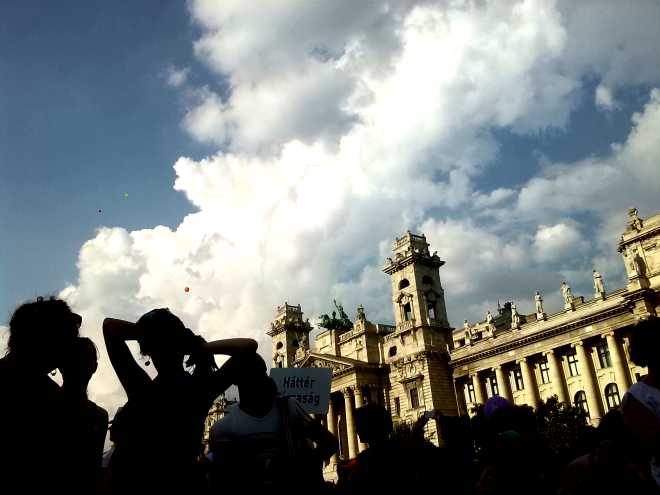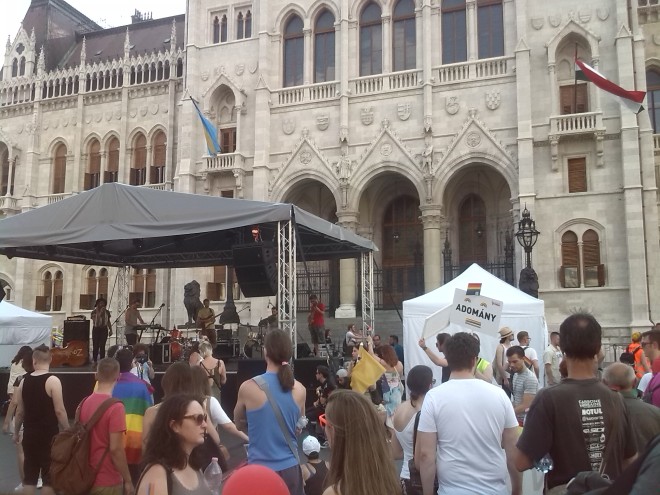
In a region as diverse as Central Europe, minorities have always played a major role. Numerous ethnic, religious, cultural, political, language-defined and more groups have emerged, evolved, survived, some benefiting from power relationships, others being persecuted. The Habsburg Empire basically consisted out of minorities. The history of Austria-Hungary is, if you want to look at it that way, a history of the interaction of small, overlapping clusters of people and their relations towards each other.
Clinging to a hegemonic system of old, not realising how the world turned under their feet, the Habsburg Empire ultimately failed. Nowadays, some of the former national minorities have their own states, but the question of who has a voice and whether it is heard remains acute. It is always a good idea to look at how “the power”, in this case the Hungarian government represented by Fidesz, handles minority issues and ask – have they learned?
So, I joined Budapest’s gay pride parade last weekend. As opposed to the last time I attended such an event, there was no police violence, but there were interesting observations to be made nonetheless.
Homosexuality, like anywhere else in the world, is a topic of ongoing debate in Hungary. Only recently, a court has overturned an older verdict, according to which labelling someone (namely ruling Fidesz party’s top-notch politician Máté Kocsis) as homosexual was to be considered as “defamation of good character”. A logic which only makes sense if A) you assume being homosexual comes with negative personal traits or B) legally speaking, something being offensive solemnly depends on whether or not someone is feeling offended by it – in which case I here and now declare that I feel personally offended by any exam grade that is not the highest grade.
But back to the pride walk.
It was generally an awesome thing. We danced through the streets, it was like a million degrees, very colourful, mainly young people around. It started at Budapest’s heroes square and ended in front of the Kossuth tér in front of the parliament.
Two noteworthy things I want to discuss about the pride walk in respect to my aforementioned question.
First of all, the police did seemingly everything possible to let no-one know about the pride walk. They prohibited anyone to join the march or even access the major streets in on its path anywhere except for at the starting point, hda even these gates closed until roughly half an hour after the march started. In some points, the fences were built 50m away from where the march would pass, and near the parliament, the perimeter was so far off, it was probably impossible to see the event from anywhere outside. Even though it is, according to organisers, dangerous to walk through Budapest with rainbow flags and the likes, this isolation of the march cannot be explained away with security measures.
I personally think that the city fathers (currently, there’s a Fidesz mayor) are somewhat embarrassed about events like this to take place in public spaces such as the Andrássy street, a world heritage site, and on the symbolism heavy Kossuth tér. They probably have use and no understanding for such emancipation movements, so trying to make it invisible – exactly the contrary of what pride walks are about – is the solution.
The other noteworthy observation I made was a Roma minority flag – a wheel on a blue and green background – hung on the main wagon.
Why a Roma flag on a queer pride walk?
In simplified terms, Roma and sexual minorities are enemies of the same ideology, one which advocates homogeneity, cultural hegemony and interprets derivation from the norm as dangerous.
Let me quickly introduce you to the concept of “group-focussed enmity” as researched for example by Bielefeld-based sociologist Andreas Zick: Scientists theorise an „ideology of unequal worth of groups“. As soon as people adopt the assumption that some groups are somewhat more valuable than others, they are prone to transfer this assumption to other groups, which is called group-focussed enmity. In other words:
- You assume that one group of people (say “gypsies”) are a homogenous group which is less valuable than “normal” people, hence its members share certain traits (other than the defining ones, whatever that is for gypsies; say you think all gypsies are being notorious thieves).
- You now transfer this idea to other groups and also assume that, say, refugees are one homogenous group of lacking worth, which’s members not only all share the defining trait that they seek refuge (which makes them refugees) but also share, for example, a hatred for women.
- Obviously, the groups considered of lower worth than your own will be endowed with negative traits. About the order “lower worth -> negative traits” rather than “negative traits -> lower worth”, I will write below.
What Zick and others found out, for example, was that in times of increased enmity against a new group – in their research Moslems in Germany – also enmities against other groups – such as classic antisemitic stereotypes – are on the rise. Even though aspects such as expression of enmity varies for different groups, there appears to be the common basis of an underlying mindset necessary for believing enmity against groups to be justifiable.
The Hungarian civil society, as almost any other society in Europe, has a long history and tradition of discriminating against Roma. Roma are generally viewed as a very homogenous entity, which is bullocks. Hungary alone has three major Roma groups speaking three major dialects of Romanes, the biggest one being Lovari. Generally, all variants of Romanes are influenced by other languages they came in touch with, hence varying all over Europe. Not even the nomadic aspect usually associated with Roma can be generalized, especially in modern day and age. The truth is; as soon as Roma no longer live up to Roma stereotypes, they are no longer visible as such and “disappear”.
These stereotypes in their negative form, in turn, exist and are nurtured to legitimize the marginalisation of the group. As discrimination studies have shown, what comes first in this process is not the stereotype out of which results a social conflict (“they are filthy, hence we must oppress them”) – but a social conflict out of which stereotypes result to justify social realities and power relationships (“they deserve how they are being treated because, uhm, they are filthy”).
The only thing that’s homogenous about Roma is the stereotype, the gypsy motive. This motive (more accurately the two motives; the mystical wildling and the parasitical thug; both nomads outside of “civilised” society), however, has been very stable and similar all over Europe since a bit more than 200 years.
The discrimination of Roma has been accordingly stout. Not so long ago, for example, thousands of people, most of the Roma, were evicted from their homes in Miskolc on an at best loose legal basis. I listened to the report of an ombudswoman to the Hungarian police about this incident, and it sounded like a pogrom. Reactions by officials to her report were somewhere between vague and ignorant and hence somewhere between sad and not surprising.
Now comes the interesting part: According to the ombudswoman, in this as well as in other incidents, affected Roma who tried to leave the country were stopped from emigrating at the airport. Apparently, the families were picked out from the cues by security in some kind of racial profiling. Why? I can only guess that at some deep level, an understanding of Roma being the doormat of the majority has entrenched itself in the collective police mind.
Ignorance and resentment – is this all Hungary’s current government has for minorities? Definitely not so.
Above Kossuth tér, two flags are hanging from the parliament building. One is, of course, the Hungarian flag, but the other one is the flag of the Székler.

Parade end point at Kossuth tér. The Székler flag is on the parliament building right above the stage.
What are Székler?
These people are a minority speaking a variety of Hungarian and living in Transylvania – yep, the vampire place. Next to featuring the noble undead, this region used to belong to the Hungarian “half” of the Habsburg Empire. After the First World War, the newly emerged Hungary was considered a defeated power and thus stripped of vast lands, many of which were inhabited actually in majority by Hungarians (others not). Ever since, the associated Treaty of Trianon is viewed with grim in Hungary and strongly shapes the national identity and politics up until today.
Nowadays, Transylvania is part of Romania. Which makes sense, given that, even though it’s a very diverse region, the majority of the population and of the regions surrounding it speaks Romanian and considers itself Romanian since Romania exists.
The Treaty of Trianon was signed almost a hundred years and several major historical events ago, including the Second World War, in the wake of which Hungary sided with the Nazis, partially to regain the lost lands. It is unthinkable that Trianon is going to be revoked, and Fidesz doesn’t explicitly demand this. By hanging up the Székler flag on the parliament, the Hungarian government communicates perhaps not the wish to actually change anything about the geographical realities in Central Europe – but they certainly raise the claim of being a “big brother” to Hungarian minorities abroad, which is in turn welcomed by Hungarian nationalists and revisionists.
I tried to research what the Székler think about another country’s unilateral decision on Székler affiliation, but couldn’t find anything. They are probably split in opinion. After all, they have neither been asked, nor does this improve their standing with the Romanians and their government – which is obviously pissed.
For the Hungarian government, however, this is an easy way out. It weakens its ties with a neighbour country, sure, but improves the standing with large parts of its own population, which is taught in schools about how Trianon was the most unfair event of history. Also, big plus in the eyes of a populist: A cause which can never be reached is a useful banner to unite followers behind if all you care about is being the banner carrier. Doesn’t make sense? Look at Britain; the populist leaders reached their goal and now don’t know what to do with it. Every next step they can take will ultimately cost support. Fidesz will never take over the multicultural melting pot that is north-western Romania. Fidesz will just sit there, sulking at the unfairness of history and pretending to be the knight in shining armor to the oppressed.
So have those currently in charge in Hungary learnt from the past?
The surprising answer is “yes”.
It would definitely be “no” if the question was asking about if they learnt how to improve the situation of marginalised minorities, strengthen their voice and thus, strengthen democracy and civil society. But I fear that the core question Fidesz strategists ask themselves is rather something along the lines of “How can we use minorities for our own good?”. Which, monarchist romanticism aside, probably was the same question Habsburg leaders and the subordinate aristocracy had foremost in mind. And probably most other leading circles anywhere, anytime. At first comes maintaining power, then making sure said power is used for good.
Final note: The Hungarian parliament building also has, as ornaments inside and on the outer walls, statues of medieval kings of noblemen perceived as Hungarian. Not in the sense of trophies, but as legitimization. Same goes for the Holy Crown of Hungary, also medieval, displayed inside. This building is perhaps the most beautiful structure I ever saw with my own eyes, but it’s also a recourse to a glorified past, designed as the expression of a certain idea of leadership and a romanticised, timeless, frozen Hungarian identity.
